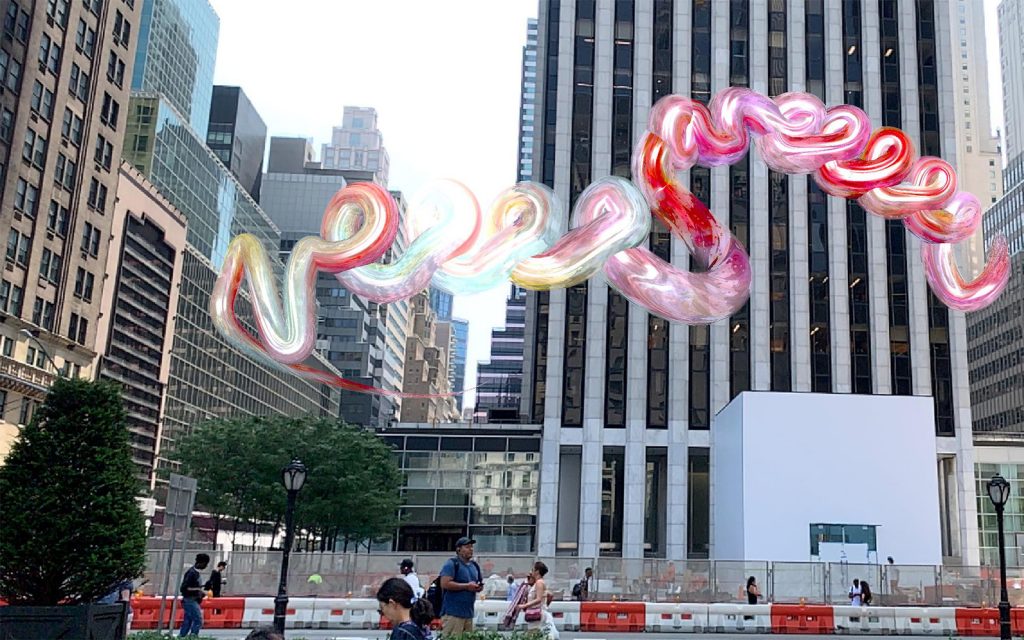Apple’s [AR]T Walk Showcases the Potential of a New Medium
Featuring work from eight artists, the augmented reality project places pieces in their stores and beyond

Augmented reality (AR), the less enveloping sibling of virtual reality, infuses the real world with imaginative additions. Often viewed through wearable lenses or through the screen of a smartphone, AR pits fantastical scenes alongside actual passersby and preexisting structures. This technological art form has become the medium of choice for Apple‘s newest experiential initiative, [AR]T Walk (curated by the New Museum‘s Lisa Phillips and Massimiliano Gioni), which debuts in select San Francisco, New York, London, Paris, Hong Kong and Tokyo stores tomorrow, 10 August.
The six aforementioned stores will be the starting point for a free guided walk (registration is required), akin to a gallery tour, that lasts about two hours and features works by Nick Cave, Nathalie Djurberg and Hans Berg, Cao Fei, John Giorno, Carsten Höller and Pipilotti Rist. Another one of Cave’s AR works, “Amass,” a digital adaption of “Until,” will be presented in all 500+ Apple stores worldwide.

The [AR]T Walk begins inside of the store, around a table outfitted with iPhones and Beats headphones. The premise of the exhibition is explained and the responsibilities of the viewer are detailed (to see, move, touch, hear, capture and anchor), all before attendees are guided out of the store. On our trial run, the first stop on the NYC walk is just outside the front door. We are instructed how to “anchor,” a process that affords an iPhone a moment to collect nearby data and situate itself. Finally, participants are led to the first art piece: Nick Cave’s “Accumul-listic Quest.”

The directions are cryptic, but hint at a broader mission running throughout [AR]T. The works presented here are not meant to be stagnant or billboard-like. They’re neither glitchy nor immobile. The works manipulate the viewer into giving feedback—whether it be literal, through touch, or figurative. By dissecting personal preferences and emotions, participants are an active part of the piece’s choreography.

Next, Nathalie Djurberg and Hans Berg’s “This Is It” delivers a fairytale-like quest deep inside Central Park. Speech bubbles—with phrases like “It’s coming” and “Around the corner, around the next bend”—lead you from the border of the park to a secluded patch of grass populated with a dozen trees. The scene that unfolds within the tree forces you to question why humanity has dragged civilization so far from the trees, the dirt and the beauty and darkness that lies within. The art does not feel manufactured but rather stumbled upon. Toward the piece’s end, superficial desires like “rides” and “drinks” are put on trial by an anthropomorphic wolf and his human-like roommate. As expected, Berg’s soundscape, which is sparse but cinematic, lends to the suspense.

As participants attempt to decipher the message of the previous piece, they’re guided down a path to the start of John Giorno’s “Now at the Dawn of My Life,” an ethereal rainbow-led jaunt through one of Giorno’s poems that ends with each graf being sent off into the skyline. Giorno himself narrates and it’s dually unnerving and soothing.

The walk continues with Cao Fei’s “Trade Eden,” an interactive depiction of a factory that grants the viewer the opportunity, by tapping or dragging boxes on a conveyor belt, to invoke chaos or establish order. Then viewers partake in Carsten Höller’s “Through,” a video game-like piece that sends users to find a randomly selected partner’s energy and then, alongside them, exit the current realm through a beaming portal. In doing so, Central Park’s Grand Army Plaza turns into an indistinguishable, glitching 2D landscape.

When all turns three-dimensional again, the walk’s most noteworthy piece (because it’s the most fun, truly captures the potential of the medium and encourages participants to chase it as it unfurls across the sky) is Pipilotti Rist’s “International Liquid Finger Prayer.” Juxtaposed with recordings of Rist’s voice—oftentimes screeching and other times delicate but nonetheless haunting—a blob-like entity pinballs off buildings, sometimes into them and then back across the sky and down to Earth just feet from where viewers stand. Participants then must chase it to keep it in view.
Contrary to what skeptics of the medium might believe, there is no lag to the experience and the piece feels equally a part of the cityscape as an artificial addition. If you go on the walk and particularly if you’re attentive to Rist’s piece, the courtyard just steps from the Plaza Hotel will never look the same.

The works that you see on the [AR]T Walk do not feel like they should exist elsewhere. They wouldn’t do well in your living room, they certainly wouldn’t resonate within the confines of an office or even traditional gallery space. “Augmented reality is a medium ripe for dynamic and visual storytelling that can extend an artist’s practice beyond the studio or the gallery and into the urban fabric,” Lisa Phillips, director for the New Museum, explains.
Because the artists themselves chose their particular locations along the walk and created art native to the project, each work feels at home in its respective corners of the park or the plaza. For that reason, and perhaps also because each walk will inherently differ from one another, [AR]T isn’t merely another show to see, it’s an ambitious attempt to be at the forefront of a burgeoning medium—one that is likely to have its own canon of accomplished artists that create works with no bounds.
Images by Evan Malachosky












